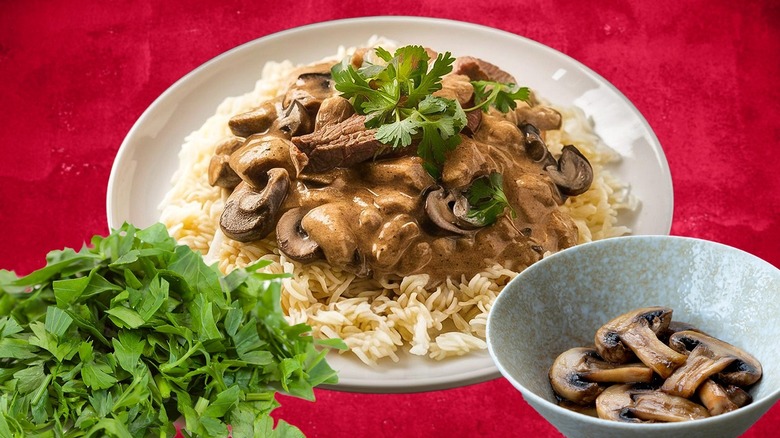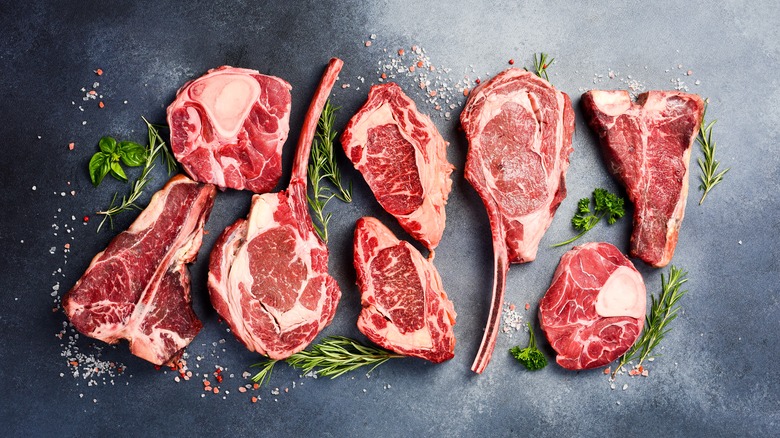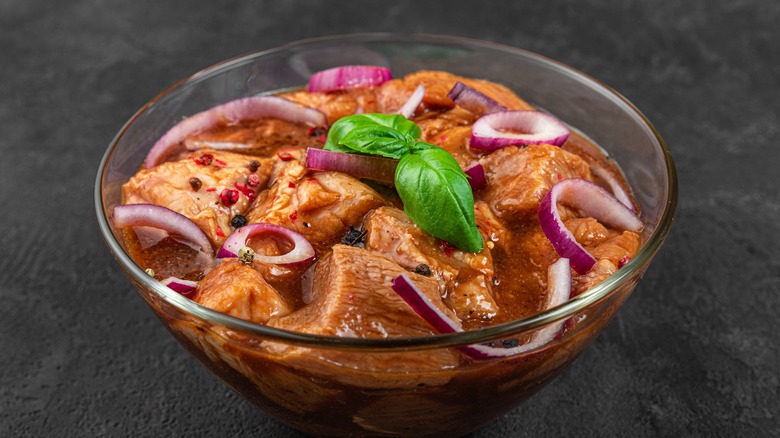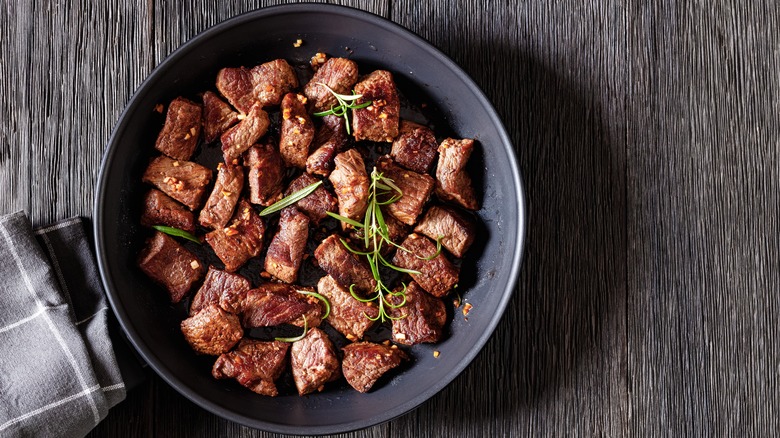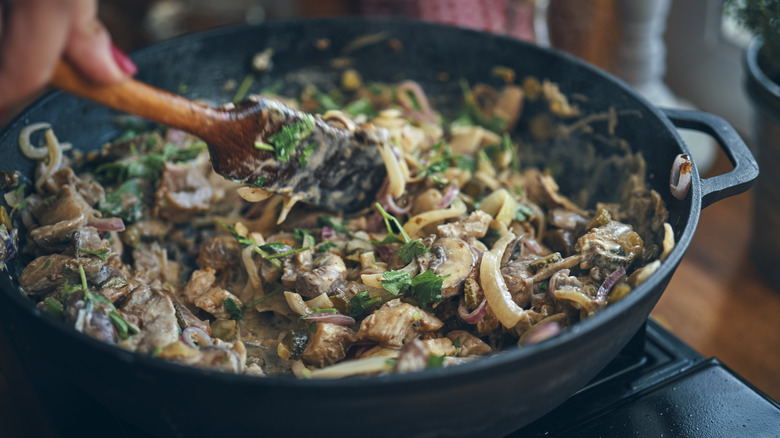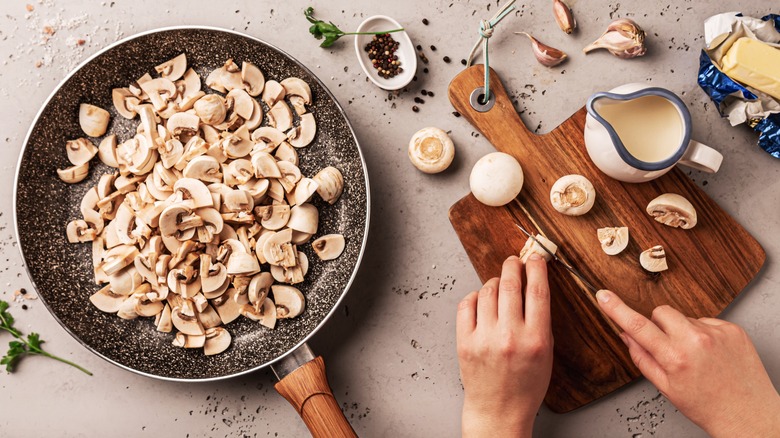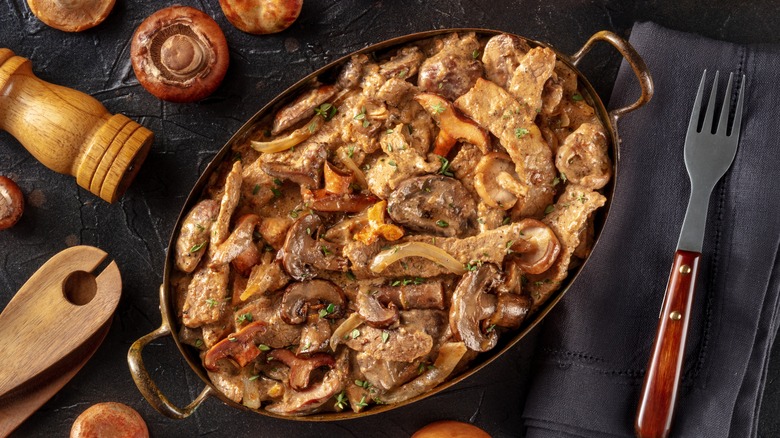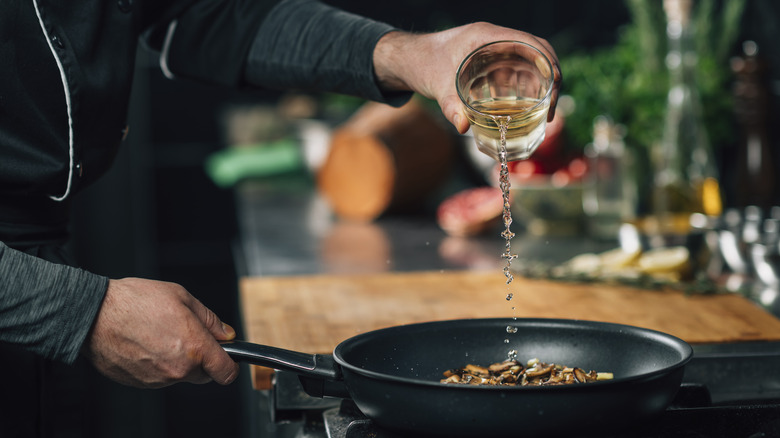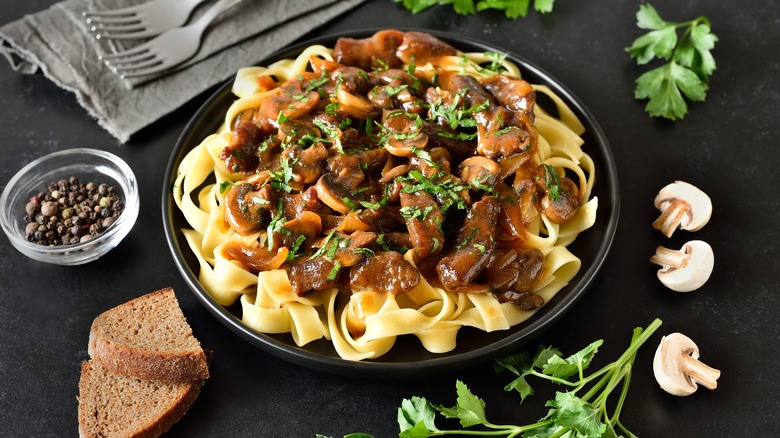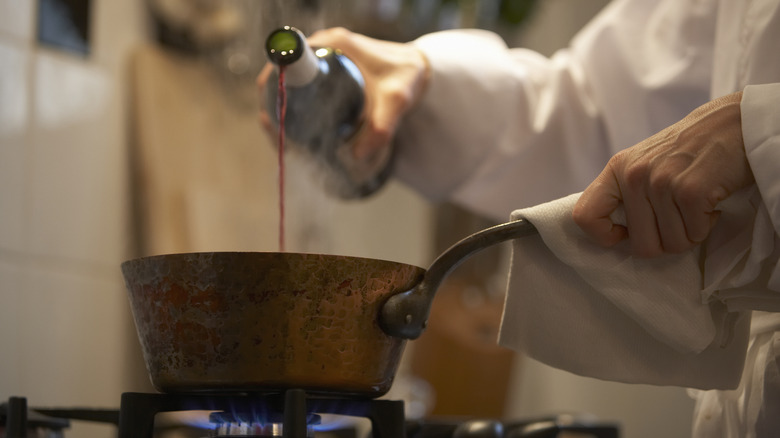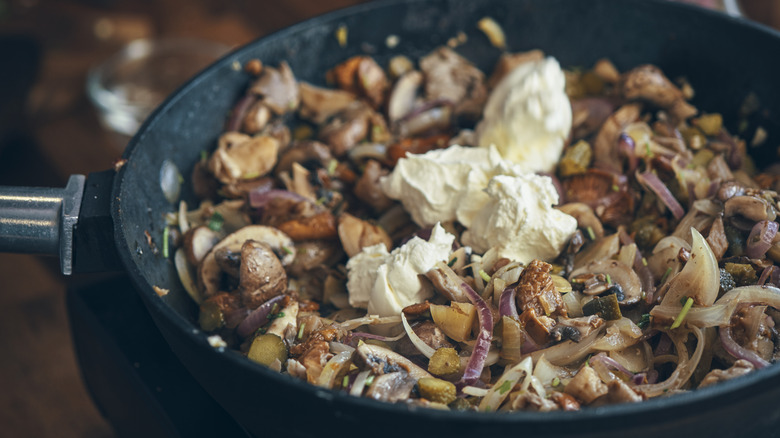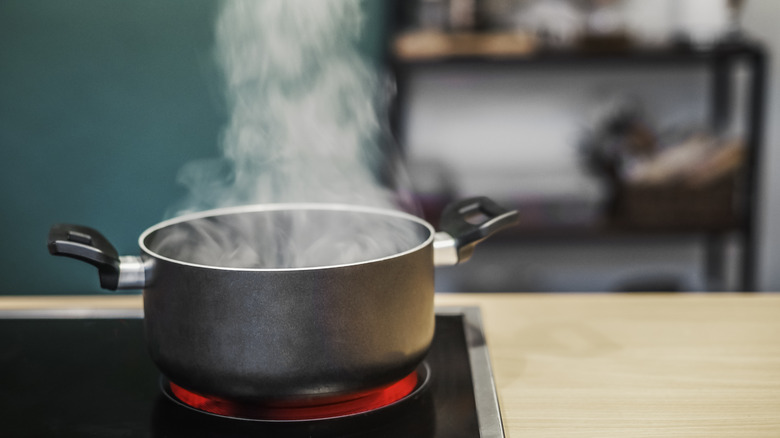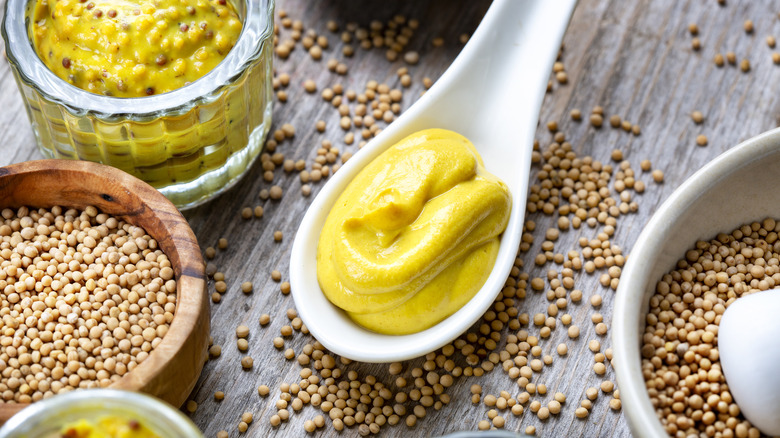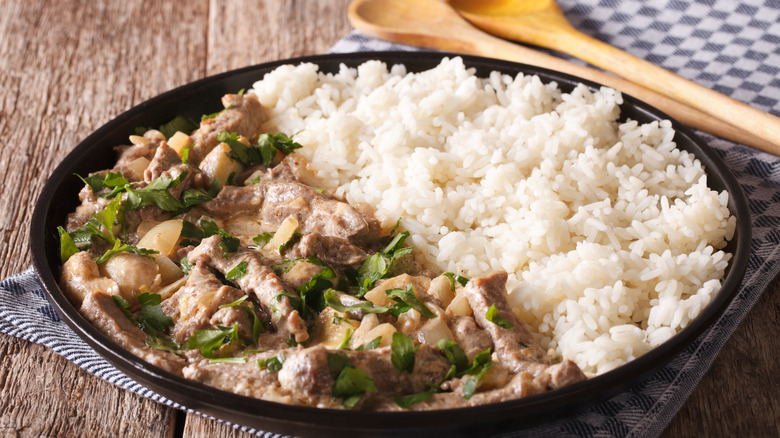Mistakes Everyone Makes When Cooking Beef Stroganoff
Named after the aristocratic Russian Stroganov family, beef Stroganoff is a decadent dish that offers comfort in every bite. Rich, creamy, and meaty, it traditionally contains sliced or cubed beef, mushrooms, and onions in a silky sour cream sauce. You can eat it on its own or serve it over egg noodles, mashed potatoes, or rice. When done right, it's a delicious dish that's every bit deserving of its illustrious name. However, when done wrong, it can be an absolute disaster.
If you've ever attempted to cook beef Stroganoff and ended up with tough meat, curdled sauce, or lackluster flavor, you're not alone. We have all fallen prey to the common mistakes people make when cooking beef Stroganoff. To figure out where we went wrong, we reached out to several chefs and culinary experts. They offered us some great advice on everything from choosing the best cuts of beef to top cooking techniques and surprising ingredients they say are an absolute must. According to the pros, these are the biggest mistakes that could be holding you back from making a truly spectacular Stroganoff.
Choosing the wrong cut of beef
Beef Stroganoff has many elements that make it a supremely satisfying dish, but there's no disputing that the star ingredient is beef. It stands to reason then that you want to find the best quality beef you can. Nearly every chef we spoke to told us the cut of beef can also make a huge difference. That's because some cuts are naturally tender and will give you juicy, succulent bites, while tougher cuts can be chewy if not cooked properly.
Many of the experts told us that the absolute best cuts of steak for beef Stroganoff are sirloin, ribeye, and tenderloin because they're flavorful, cook quickly, and stay tender. However, that's not to say that tougher cuts are a lost cause. Meghan Birnbaum, founder of Meghan It Up, told Chowhound, "If you're using less expensive cuts like chuck or round, they need a bit more time to get tender, so you might want to braise them first or use a meat mallet to tenderize them." You might also want to consider using a slow cooker or an Instant Pot for those tougher cuts of beef.
Not velveting your meat beforehand
Even with the right cut of beef, you still might end up with meat that isn't as soft as you would like it to be. Fortunately, there are a few ways to get around that. JD Alewine, co-founder of Them Bites, told us that velveting is the secret to supremely succulent beef. He said, "Velveting meat is a Chinese cooking technique used to keep meat tender and juicy during stir-frying or other high-heat cooking methods."
Although it sounds rather extravagant, velveting meat is pretty simple. All you need to do is coat the meat in a slurry of cornstarch and water and let it marinate for 30 minutes to an hour. Some people use baking soda instead of cornstarch and replace water with egg whites. You can also add some seasoning to the mix for extra flavor. The next step is to quickly blanch the meat in water or oil before the final cook to give it a nice glossy sheen. Alewine said, "This technique helps create a silky, tender texture, which is where the term 'velveting' comes from."
Overcooking the beef
Another mistake home cooks often make with beef Stroganoff is overcooking the meat. The longer you cook those tender cuts of beef, the more the natural juices will evaporate out, which can cause the meat to become dry and rubbery. While tougher cuts need to cook longer to break down the connective tissue, you don't want to go too far. The meat can start to fall apart and give you something more akin to pulled beef than tender chunks of beef with a good bite. The length of time you cook your beef depends on the cut you're using and the cooking method.
If you're planning on using a tender cut of beef, Meghan Birnbaum offered a great tip for keeping the meat juicy. "Sear the beef quickly over high heat and then add it to the sauce at the end just to warm it through. This way, you'll keep that perfect texture and avoid a chewy meaty bite," she said. For tougher cuts, you also want to sear the meat first to give it a nice caramelized flavor. Then, you can braise the beef in a Dutch oven or cook it in a slow cooker until it's fork tender.
Rushing the cooking process
If you're strapped for time and want to create a delicious meal fast, you may be tempted to rush through the steps for making beef Stroganoff. However, many chefs say this is a huge mistake. "Time is key. I have seen people make this unsuccessfully in a pan in 15 minutes and wonder why the meat is tough or dry and lacks a depth of flavor," Jason Kennedy, in-house meat expert at Verde Farms. According to Kennedy, the best way to make beef Stroganoff is in the oven or a slow cooker.
It may take longer to slow-cook your beef Stroganoff, but that gives the flavors more time to meld together. Plus, you can save yourself time doing dishes because everything goes in one pot. Kennedy suggested searing the meat in a Dutch oven so that the juices and char remain while cooking. Then, you can add your other ingredients before placing it in the oven. "A good Stroganoff needs up to 1.5 hours baked in a Dutch oven or four hours in a slow cooker," he said.
Mishandling the mushrooms
You might think that mushrooms are one of the easiest elements of beef Stroganoff to master. Just slice, season, and saute them and you're good to go, right? Well, not exactly. Several of the experts we spoke to said this is one step that many people mess up. Make mistakes with your mushrooms and you could end up with bland, watery, or leathery fungi.
Mushrooms contain a lot of water, so the key is to cook the moisture out without completely desiccating them. Jim Carroll of Meat and Greet BBQ recommended leaving plenty of space in the pan so you can get a nice golden brown color on your mushrooms. "Overcrowding the pan can lead to steaming instead of browning, which affects flavor and texture," he said.
Jessica Formicola of Savory Experiments offered another tip for amping up the taste and texture of the mushrooms. "I like to cook my mushrooms first, sweating out most of the water and then rehydrating them with highly flavorful liquids like beef broth, red wine, or white wine," she said. Formicola also suggested removing the mushrooms while building the sauce and adding them in with the cooked beef at the end.
Overcomplicating the vegetables
Part of the beauty of beef Stroganoff is how decadent it can be with just a few key ingredients. At its essence, it's mainly beef, mushrooms, and onions in a creamy sauce. That leads some people to get creative with add-ins like various veggies. While many chefs say there's nothing wrong with throwing in an extra vegetable or two, most say that you don't want to go overboard. After all, those flavor combos are classic for a reason.
Fanila Nawaby, chef and owner of Mimi's Kabob, said, "While onions and mushrooms are staples, adding too many vegetables can distract from the classic flavors. Stick to simple vegetables like onions and garlic or a small amount of peas for added sweetness." Rena Awada of Healthy Fitness Foods added, "I would avoid vegetables that release too much liquid, like zucchini or eggplant, as they can make the sauce watery. If you want to add some greens, lightly wilted spinach or kale can be a great addition without affecting the texture of the dish too much."
Skipping the deglazing step
Once you've seared your beef, sauteed your mushrooms, and softened your onions, you'll probably notice brown bits collecting in the bottom of your pan. This is called fond in foodie speak and it creates a great opportunity for building flavor. That is, provided the fond isn't burnt to a crisp. Many home cooks neglect to deglaze the fond or opt to get rid of it altogether. Chefs will tell you this is a big mistake because you'll be missing out on adding another layer of depth to your beef Stroganoff.
Deglazing is a pretty simple process that only takes a few minutes. Simply add wine, water, or broth to the hot pan and stir it to break up all those brown bits. Let the liquid simmer down so that some of it evaporates and the flavors become more concentrated. The timing of deglazing is also important. Fanila Nawaby said, "Deglaze with broth or wine before making the sauce to capture all that richness." When the pan is deglazed, you can add your remaining sauce ingredients to build on that rich base you've just created.
Leaving out fresh herbs
Fresh herbs may not be the first thing you think of with a rich and creamy stew-like dish like beef Stroganoff, but many chefs say you would be remiss to leave out a touch of herbaceous greenery. Herbs and spices can add a fresh element to the richness of the sauce and create additional layers of flavor. "Herbs and spices can definitely elevate the dish without overwhelming it. These should be used sparingly to complement the dish rather than dominate it," said Jessica Randhawa, head chef and owner of The Forked Spoon.
One herb that many chefs recommended is fresh dill. Rena Awada said, "Dill has a unique, fresh taste that adds a hint of brightness to the dish, complementing the rich and creamy sauce beautifully." Some of the other experts we spoke to suggested parsley, thyme, and tarragon. Many also like adding a pinch of smoked paprika. The trick is to add the seasonings a little bit at a time and taste-test as you go along. Remember that you can always add more seasoning, but taking it away once it's in the dish is more difficult.
Neglecting wine or brandy
If you want to add some extra oomph to your beef Stroganoff, alcohol may be just the thing you need. In fact, some chefs say it's a must. Jim Carroll said, "Authentic Stroganoff often includes a splash of brandy or white wine in the sauce, adding depth and complexity to the flavor profile." You can use brandy or wine to deglaze your pan, add it directly into your sauce, or include it in the braising liquid if you're going the slow-cooking route.
Alcohol doesn't just add extra flavor to beef Stroganoff, it can also enhance the flavors of the other ingredients. That's because alcohol bonds to certain molecules, allowing those flavors to shine. It also helps break down proteins in meats, so it may make your beef more tender than it would be otherwise. Don't be afraid to experiment with different alcohols like cognac, red wine, or sherry. Jason Kennedy revealed, "I add a splash of vodka, which I'm not sure is an authentic Russian Stroganoff ingredient, but I bet it's used there!"
Adding cold sour cream to a hot pan
Can't figure out why your beef Stroganoff sauce keeps curdling? It may be the temperature of your sour cream. Adding cold sour cream to your hot sauce is a fast track to grainy, separated sauce. The science behind why cream curdles all comes down to the proteins. When cold sour cream encounters high heat, the proteins in the cream break apart from the water and clump together. That's what causes those unappetizing-looking clusters in curdled sauce.
Fortunately, there are a few ways to avoid the dreaded curdled sauce. Pinch and Swirl founder Marissa Stevens told us, "To prevent this, always use room temperature sour cream and add it on low heat, stirring constantly. Tempering the sour cream by mixing in a little of the hot Stroganoff sauce before adding it to the pan can also help." Tempering is a good trick to have in your repertoire because it can help with a wide array of dishes. It can prevent cream from curdling in soup, stop eggs from separating in hollandaise sauce, and solve the problem of clumpy custards.
Letting the sauce boil over
So you did your due diligence and tempered your sour cream, but your sauce still curdled. What went wrong? The most likely answer is that you let your sauce boil over. Jim Carroll told us, "A runny or curdled sauce is often due to improper temperature control or adding sour cream too early. To achieve the right consistency, add the sour cream at the end and avoid boiling the sauce after its addition."
Ideally, you want to reduce your sauce and then lower the temperature or take the pan off the heat entirely before adding your tempered sour cream. Whisk the sour cream to fully incorporate it into the sauce and then add your beef. If you need to reheat the sauce, do it gently over low heat to prevent curdling. If you go a bit too high with the heat and see the sauce starting to separate, all is not lost. According to Jessica Formicola, "Curdled sauce is hard to revive, but it can be done by vigorously whisking in one to two tablespoons of butter at a low temperature."
Forgetting to add a touch of mustard
Beef Stroganoff may have originated in Russia, but many believe that it was heavily influenced by French cooking techniques. The wealthy Strogonov family often employed French chefs, so it makes sense that they would use familiar ingredients from France. That could be why many classic beef Stroganoff recipes call for the addition of mustard. Home cooks may leave this pungent ingredient out, but many of the experts we spoke to said it can really amp up your dish.
Marissa Stevens told us, "An authentic touch often overlooked is adding a small amount of prepared mustard at the very end after the sour cream. This adds a subtle tang that really enhances the flavor without tasting 'mustardy.'" Bright and acidic, mustard can cut through the rich creaminess of the sauce and provide a subtle hint of heat. It can also help thicken your sauce. You can use Dijon mustard, grainy mustard, or plain old yellow mustard. If you want to go slightly more subtle, you can also use mustard powder.
Picking the wrong accompaniment
While the experts we spoke to agreed on many aspects of making beef Stroganoff like proper cooking techniques for the beef and how to prevent the sour cream from curdling, they differed on their preferred accompaniments. The classic pairings for beef Stroganoff are typically egg noodles, mashed potatoes, or rice. According to what the chefs had to say, there are strong arguments for each.
Jessica Randhawa said egg noodles were her choice because, "Their rich, slightly eggy flavor pairs beautifully with the creamy sauce, providing a delightful contrast in textures that complements the overall dish." Jason Kennedy said, "Mashed potatoes help soak up the gravy and can easily be scooped up with each piece of meat to have all ingredients in a bite." In the rice camp, Rena Awada said, "Rice is light and doesn't overpower the dish, letting the rich flavors of the beef stroganoff shine, which is exactly what you want."
Clearly, the best sides for beef Stroganoff come down to personal taste. Don't be afraid to switch yours up or try different options like cauliflower, wild rice, or couscous. After all, it's your beef Stroganoff and you can eat it just the way you like.
